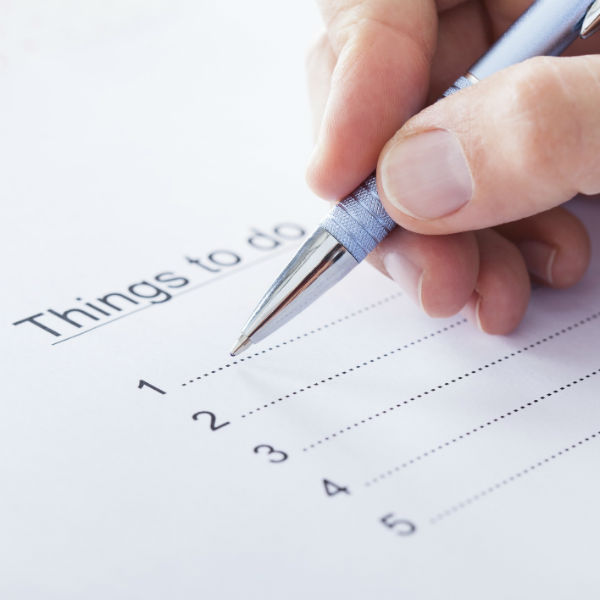 In helping children, adolescents, and even adults with attention-deficit hyperactivity (ADHD), a checklist is a basic but extremely effective tool if used properly. Checklists are helpful in remembering to complete tasks, staying on track with budgeting time, and maintaining a record.
In helping children, adolescents, and even adults with attention-deficit hyperactivity (ADHD), a checklist is a basic but extremely effective tool if used properly. Checklists are helpful in remembering to complete tasks, staying on track with budgeting time, and maintaining a record.
Here are a few common uses for checklists among those affected by ADHD:
- Listing items that need to be completed as part of a morning routine (such as brushing teeth, packing lunch, making the bed, or double-checking a backpack for homework).
- Tracking things that need to be done before bed (putting clothes out for the morning, etc.).
- Tracking items that need to be packed at the end of the school or work day to go home (binders, folders, books, lunch box, etc.).
- Staying abreast of tasks that need to be completed at work.
- Tracking homework assignments that need to be completed each night.
- Keeping track of items that need to be packed for a trip.
- As a schedule for completing specific tasks within an allotted period of time.
Here are some suggestions on how to display a checklist:
- App on smartphone, iPod, iPad, etc., such as Wunderlist, Reminders, To-Do.
- Large whiteboard in bedroom, bathroom, or other area.
- Laminated piece of paper that can be used again.
- Piece of paper that can be copied.
- Notepad that can be carried around.
- On a commonly used mirror.
- Sticky notes in different parts of the room/living space corresponding to specific tasks.
Over time, individuals often learn to internalize the idea of a checklist and may be able to carry out routine tasks successfully without having to continue to rely on a physical checklist.
A sample checklist for a morning routine:
__ Brush teeth
__ Shower
__ Make bed
__ Get dressed
__ Eat breakfast
__ Pack backpack
One can include specific time-frame goals for tasks to be completed as well (i.e., “pack backpack – 7:45 a.m.”).
A sample checklist for homework assignments:
__ Math: worksheet (10 minutes)
__ English: chapters 4 and 5 (30 minutes)
__ Science: short-answer questions (20 minutes)
A sample checklist for daily work tasks:
__ 9 a.m. to 10 a.m.: Proposal project
__ 10 a.m. to 10:15 a.m.: Break
__ 10:15 a.m. to 11:45 a.m.: Meeting
__ 11:45 a.m. to 12:30 p.m.: Return phone calls/email
__ 12:30 p.m. to 1:30 p.m.: Lunch
__ 1:30 p.m. to 3 p.m.: Finish inventory
__ 3 p.m. to 4:30 p.m.: Review of accounts
__ 4:30 p.m. to 5 p.m.: Return phone calls/email
When creating a checklist, there are a few important things to keep in mind. First, make sure that the creation of a checklist does not take a large amount of time. Also be sure that the way the checklist is set up is easy to follow. It is important not to force the use of a specific checklist on a child, adolescent, or adult; this goes for most strategies and tools. Try to work collaboratively with the person, get his or her input, and figure out a compromise that includes his or her ideas. If you do this, an individual is more likely to use the checklist.
If you try a checklist and it doesn’t work well, examine what did not work. It may lead to revamping how the checklist is created, displayed, or used. In other situations, it may mean finding an alternative strategy.

The preceding article was solely written by the author named above. Any views and opinions expressed are not necessarily shared by GoodTherapy.org. Questions or concerns about the preceding article can be directed to the author or posted as a comment below.


 4 Keys to Better Communication with ADHD Clinicians
4 Keys to Better Communication with ADHD Clinicians Do You Really Understand How Your Child Experiences ADHD?
Do You Really Understand How Your Child Experiences ADHD? Don't Let ADHD Consume Your Relationship: Know the Signs
Don't Let ADHD Consume Your Relationship: Know the Signs

Please fill out all required fields to submit your message.
Invalid Email Address.
Please confirm that you are human.
Leave a Comment
By commenting you acknowledge acceptance of GoodTherapy.org's Terms and Conditions of Use.